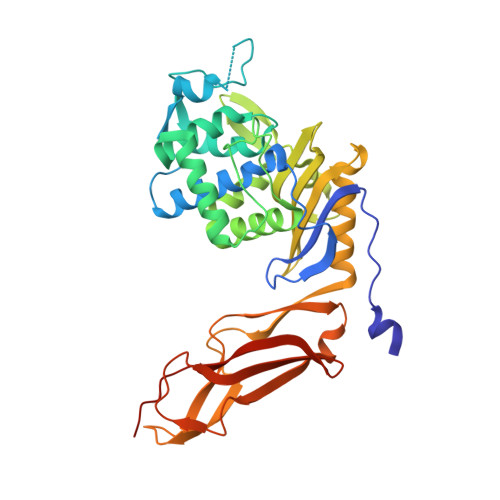A large displacement of the SXN motif of Cys115-modified penicillin-binding protein 5 from Escherichia coli.
Nicola, G., Fedarovich, A., Nicholas, R.A., Davies, C.(2005) Biochem J 392: 55-63
- PubMed: 16038617
- DOI: https://doi.org/10.1042/BJ20050449
- Primary Citation of Related Structures:
1NZU, 1SDN - PubMed Abstract:
Penicillin-binding proteins (PBPs), which are the lethal targets of beta-lactam antibiotics, catalyse the final stages of peptidoglycan biosynthesis of the bacterial cell wall. PBP 5 of Escherichia coli is a D-alanine CPase (carboxypeptidase) that has served as a useful model to elucidate the catalytic mechanism of low-molecular-mass PBPs. Previous studies have shown that modification of Cys115 with a variety of reagents results in a loss of CPase activity and a large decrease in the rate of deacylation of the penicilloyl-PBP 5 complex [Tamura, Imae and Strominger (1976) J. Biol. Chem. 251, 414-423; Curtis and Strominger (1978) J. Biol. Chem. 253, 2584-2588]. The crystal structure of wild-type PBP 5 in which Cys115 fortuitously had formed a covalent adduct with 2-mercaptoethanol was solved at 2.0 A (0.2 nm) resolution, and these results provide a structural rationale for how thiol-directed reagents lower the rate of deacylation. When compared with the structure of the unmodified wild-type enzyme, a major change in the architecture of the active site is observed. The two largest differences are the disordering of a loop comprising residues 74-90 and a shift in residues 106-111, which results in the displacement of Ser110 of the SXN active-site motif. These results support the developing hypothesis that the SXN motif of PBP 5, and especially Ser110, is intimately involved in the catalytic mechanism of deacylation.
Organizational Affiliation:
Department of Biochemistry and Molecular Biology, Medical University of South Carolina, Charleston, SC 29425, USA.















